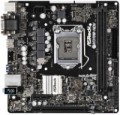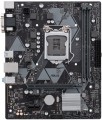Power phases
The number of processor power phases provided on the motherboard.
Very simplistically, phases can be described as electronic blocks of a special design, through which power is supplied to the processor. The task of such blocks is to optimize this power, in particular, to minimize power surges when the load on the processor changes. In general, the more phases, the lower the load on each of them, the more stable the power supply and the more durable the electronics of the board. And the more powerful the CPU and the more cores it has, the more phases it needs; this number increases even more if the processor is planned to be overclocked. For example, for a conventional quad-core chip, only four phases are often enough, and for an overclocked one, at least eight may be needed. It is because of this that powerful processors can have problems when used on inexpensive low-phase motherboards.
Detailed recommendations on choosing the number of phases for specific CPU series and models can be found in special sources (including the documentation for CPU itself). Here we note that with numerous phases on the motherboard (more than 8), some of them can be virtual. To do this, real electronic blocks are supplemented with doublers or even triplers, which, formally, increases the number of phases: for example, 12 claimed phases can represent 6 physical blocks with doublers. However, virtual phases are much inferior to real ones in terms of capabilities — in fact, t...hey are just additions that slightly improve the characteristics of real phases. So, let's say, in our example, it is more correct to speak not about twelve, but only about six (though improved) phases. These nuances must be specified when choosing a motherboard.
Size (HxW)
Motherboard dimensions in height and width. It is assumed that the traditional placement of motherboards is vertical, so in this case one of the dimensions is called not the length, but the height.
Motherboard sizes are largely determined by their form factors (see above), however, the size of a particular motherboard may differ slightly from the standard adopted for this form factor. In addition, it is usually easier to clarify the dimensions according to the characteristics of a particular motherboard than to look for or remember general information on the form factor. Therefore, size data can be given even for models that fully comply with the standard.
The third dimension — thickness — is considered less important for a number of reasons, so it is often omitted.
1x PCI-E slots
Number of PCI-E (PCI-Express) 1x slots installed on the motherboard. There are
motherboards for 1 PCI-E 1x slot,
2 PCI-E 1x slots,
3 PCI-E 1x ports and even more.
The PCI Express bus is used to connect various expansion cards — network and sound cards, video adapters, TV tuners and even SSD drives. The number in the name indicates the number of PCI-E lines (data transfer channels) supported by this slot; the more lines, the higher the throughput. Accordingly, PCI-E 1x is the basic, slowest version of this interface. The data transfer rate for such slots depends on the PCI-E version (see "PCI Express Support"): in particular, it is slightly less than 1 GB / s for version 3.0 and slightly less than 2 GB / s for 4.0.
Separately, we note that the general rule for PCI-E is as follows: the board must be connected to a slot with the same or more lines. Thus, only single-lane boards will be guaranteed to be compatible with PCI-E 1x.
USB 2.0
The number of USB 2.0 connectors provided on the motherboard.
USB connectors (all versions) are used to connect to the "motherboard" USB ports located on the front panel of the case. With a special cable, such a port is connected to the connector, while one connector, usually, works with only one port. In other words, the number of connectors on the motherboard corresponds to the maximum number of front USB connectors that can be used with it.
Specifically, USB 2.0 is the oldest version widely used nowadays. It provides data transfer rates up to 480 Mbps, is considered obsolete and is gradually being replaced by more advanced standards, primarily USB 3.2 gen1 (formerly USB 3.0). Nevertheless, a lot of peripherals are still being produced under the USB 2.0 connector: the capabilities of this interface are quite enough for most devices that do not require a high connection speed.
HDMI output
The motherboard has its own
HDMI output.
Such an output is intended for transmitting video from an integrated graphics card (see above) or a processor with integrated graphics (we emphasize that it is impossible to output a signal from a discrete graphics card through the motherboard chipset). As for HDMI specifically, it is a combined digital video/audio interface specifically designed to work with HD resolutions and multi-channel audio. Today it is the most common of these interfaces, HDMI support is almost mandatory for video devices that are compatible with HD standards.
The specific capabilities of HDMI vary by version (see below for more details), but in general they are quite impressive — even in the earliest (current today) HDMI v.1.4, the maximum resolution is 4K, and in newer standards it reaches 10K. So in motherboards, the quality of the video transmitted through such an output is often limited not by the interface capabilities, but by the graphics performance of the system.
LAN controller
Model of the LAN controller installed in the motherboard.
The LAN controller provides data exchange between the card and the network port(s) of the computer. Accordingly, both general characteristics and individual features of the network functionality of the "motherboard" depend on the characteristics of this module: support for special technologies, connection quality in case of unstable communication, etc. Knowing the model of the LAN controller, you can find detailed data on it — including including practical reviews; this information is rarely needed by the average user, but it can be useful for online game enthusiasts and for some specific tasks.
Thus, the LAN controller model is specified mainly in cases where it is a rather advanced solution that is noticeably superior to standard models. Such solutions are currently produced mainly under the brands
Intel(middle level),
Realtek(relatively simple models),
Aquntia and
Killer(mostly advanced solutions).
USB 2.0
The number of USB 2.0 connectors installed on the back of the motherboard.
Recall that USB is the most popular modern connector for connecting various external peripherals — from keyboards and mice to specialized equipment. And USB 2.0 is the oldest version of this interface that is relevant today; it is noticeably inferior to the newer USB 3.2 both in terms of speed (up to 480 Mbps), and in terms of power supply and additional functionality. On the other hand, even such characteristics are often enough for undemanding peripherals (like the same keyboards / mice); and devices of newer versions can be connected to the connectors of this standard — there would be enough power supply. So this version of USB is still found in modern motherboards, although there are fewer and fewer new models with USB 2.0 connectors.
Note that in addition to the connectors on the rear panel, connectors on the board itself (more precisely, ports on the PC case connected to such connectors) can also provide a USB connection. See below for more on this.
PS/2
The number of PS/2 ports provided in the design of the motherboard.
PS/2 is a dedicated port designed to connect exclusively to keyboards and/or mice. The traditional motherboard configuration for a PC provides 2 such ports — for the keyboard (usually highlighted in lilac) and for the mouse (green). However, there are boards with one connector, to which you can connect any of these types of peripherals, to choose from. Anyway, the presence of PS/2 can save the user from having to occupy USB ports for the keyboard / mouse; this is especially useful if you have to deal with a lot of other USB peripherals. On the other hand, for a number of reasons, this connector is considered obsolete and is used less and less; and PS/2 peripherals are produced mainly in the form of USB devices, additionally equipped with PS/2 adapters.
CPU power
The type of connector for powering the processor installed on the motherboard.
Most modern boards use a
4-pin connector, and most power supplies in ATX cases are also designed for it. In addition, there are other types of power connectors, they all have an even number of pins — 2, 6 or 8. Two-pin
power is used mainly in motherboards of miniature form factors like thin mini-ITX, designed for low-power processors.
8-pin connectors, on the contrary, are designed to power the most powerful modern processors. It is believed that such a connector provides a more stable power supply and more precise tuning of its parameters. But connectors for 6 pins are not found separately, they usually complement 8-pin connectors in high-performance motherboards, in particular, gaming ones.
Also note that some boards have 2 or even 3 power connectors — most often in the format
8 + 4,
8 + 8 and
8 + 8 + 6 pins. This functionality is designed for high-end CPUs with high power and power consumption, for which one connector is not enough. There is another specific option — “motherboards”
without a separate processor power supply : these are models equipped with an integrated CPU, which receives energy through its own board circuits without a sp
...ecial power connector.
